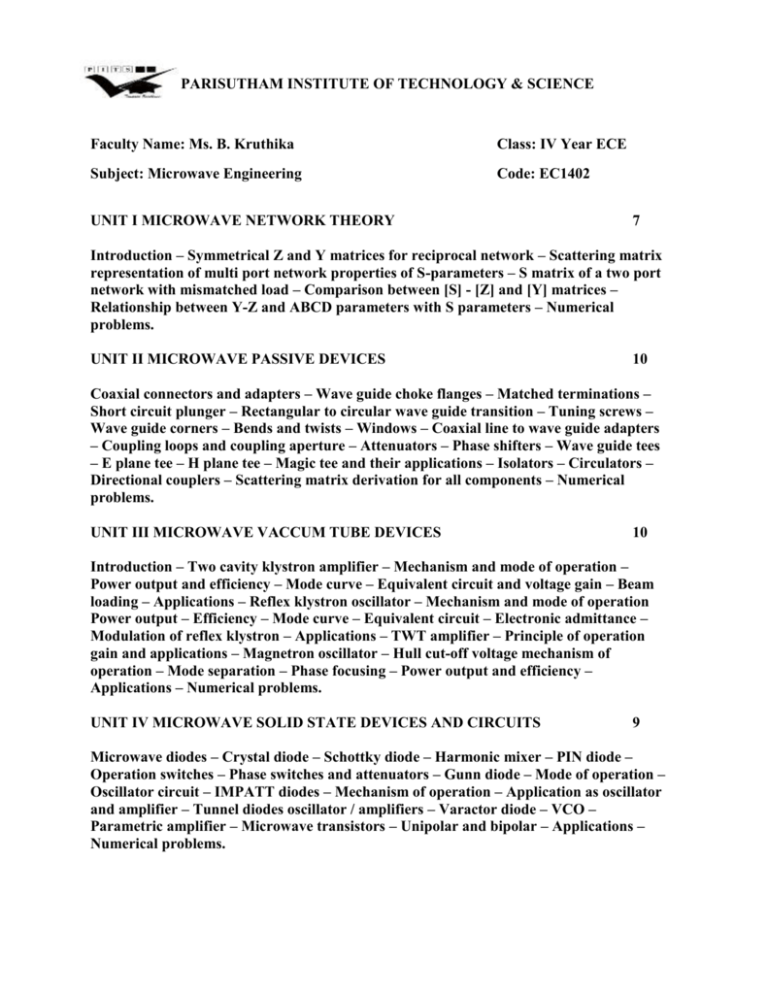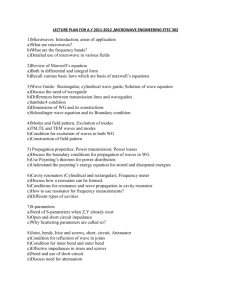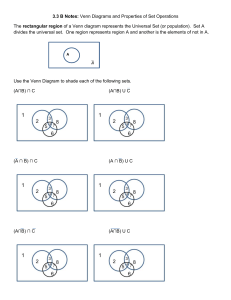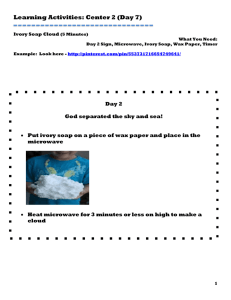Sylabus
advertisement

PARISUTHAM INSTITUTE OF TECHNOLOGY & SCIENCE Faculty Name: Ms. B. Kruthika Class: IV Year ECE Subject: Microwave Engineering Code: EC1402 UNIT I MICROWAVE NETWORK THEORY 7 Introduction – Symmetrical Z and Y matrices for reciprocal network – Scattering matrix representation of multi port network properties of S-parameters – S matrix of a two port network with mismatched load – Comparison between [S] - [Z] and [Y] matrices – Relationship between Y-Z and ABCD parameters with S parameters – Numerical problems. UNIT II MICROWAVE PASSIVE DEVICES 10 Coaxial connectors and adapters – Wave guide choke flanges – Matched terminations – Short circuit plunger – Rectangular to circular wave guide transition – Tuning screws – Wave guide corners – Bends and twists – Windows – Coaxial line to wave guide adapters – Coupling loops and coupling aperture – Attenuators – Phase shifters – Wave guide tees – E plane tee – H plane tee – Magic tee and their applications – Isolators – Circulators – Directional couplers – Scattering matrix derivation for all components – Numerical problems. UNIT III MICROWAVE VACCUM TUBE DEVICES 10 Introduction – Two cavity klystron amplifier – Mechanism and mode of operation – Power output and efficiency – Mode curve – Equivalent circuit and voltage gain – Beam loading – Applications – Reflex klystron oscillator – Mechanism and mode of operation Power output – Efficiency – Mode curve – Equivalent circuit – Electronic admittance – Modulation of reflex klystron – Applications – TWT amplifier – Principle of operation gain and applications – Magnetron oscillator – Hull cut-off voltage mechanism of operation – Mode separation – Phase focusing – Power output and efficiency – Applications – Numerical problems. UNIT IV MICROWAVE SOLID STATE DEVICES AND CIRCUITS 9 Microwave diodes – Crystal diode – Schottky diode – Harmonic mixer – PIN diode – Operation switches – Phase switches and attenuators – Gunn diode – Mode of operation – Oscillator circuit – IMPATT diodes – Mechanism of operation – Application as oscillator and amplifier – Tunnel diodes oscillator / amplifiers – Varactor diode – VCO – Parametric amplifier – Microwave transistors – Unipolar and bipolar – Applications – Numerical problems. UNIT V MICROWAVE MEASUREMENTS 9 Introduction – Tunable detector – Slotted line carriage – VSWR meter – Spectrum analyzer – Network analyzer – Power measurements – Schottky barrier diode sensor – Bolometer sensor – Power sensor – High power measurement – Insertion loss and attenuation measurement – VSWR measurement – Low and high VSWR – Impedance measurement – Frequency measurement – Measurement of cavity Q – Dielectric measurement of a solid by wave-guide method – Antenna measurement – Radiation pattern – Phase and gain. TEXT BOOK 1. Annapurna Das, Sisir K. Das, “Microwave Engineering”, TMH Co., Ltd., 1999. Reprint 2001. REFERENCES 1. Collin R.E., “Foundation of Microwave Engineering”, 2nd Edition, TMH, 1992. 2. Samuel Y. Liao, “Microwave devices and Circuits”, PHI Pvt Ltd., 1995. 3. Reich J.H. et al, “Microwave”, East West Press, 1978. UNIT I MICROWAVE NETWORK THEORY 7 Introduction – Symmetrical Z and Y matrices for reciprocal network – Scattering matrix representation of multi port network properties of S-parameters – S matrix of a two port network with mismatched load – Comparison between [S] – [Z] and [Y] matrices –Relationship between Y-Z and ABCD parameters with S parameters – Numerical problems. UNIT II MICROWAVE PASSIVE DEVICES 10 Coaxial connectors and adapters – Wave guide choke flanges – Matched terminations – Short circuit plunger – Rectangular to circular wave guide transition – Tuning screws – Wave guide corners – Bends and twists – Windows – Coaxial line to wave guide adapters – Coupling loops and coupling aperture – Attenuators – Phase shifters – Wave guide tees – E plane tee – H plane tee – Magic tee and their applications – Isolators – Circulators – Directional couplers – Scattering matrix derivation for all components – Numerical problems. UNIT III MICROWAVE VACCUM TUBE DEVICES 10 Introduction – Two cavity klystron amplifier – Mechanism and mode of operation – Power output and efficiency – Mode curve – Equivalent circuit and voltage gain – Beam loading – Applications – Reflex klystron oscillator – Mechanism and mode of operation Power output – Efficiency – Mode curve – Equivalent circuit – Electronic admittance – Modulation of reflex klystron – Applications – TWT amplifier – Principle of operation gain and applications – Magnetron oscillator – Hull cut-off voltage mechanism of operation – Mode separation – Phase focusing – Power output and efficiency – Applications – Numerical problems. UNIT IV MICROWAVE SOLID STATE DEVICES AND CIRCUITS 9 Microwave diodes – Crystal diode – Schottky diode – Harmonic mixer – PIN diode – Operation switches – Phase switches and attenuators – Gunn diode – Mode of operation – Oscillator circuit – IMPATT diodes – Mechanism of operation – Application as oscillator and amplifier – Tunnel diodes oscillator / amplifiers – Varactor diode – VCO – Parametric amplifier – Microwave transistors – Unipolar and bipolar – Applications – Numerical problems. UNIT V MICROWAVE MEASUREMENTS 9 Introduction – Tunable detector – Slotted line carriage – VSWR meter – Spectrum analyzer – Network analyzer – Power measurements – Schottky barrier diode sensor – Bolometer sensor – Power sensor – High power measurement – Insertion loss and attenuation measurement – VSWR measurement – Low and high VSWR – Impedance measurement – Frequency measurement – Measurement of cavity Q – Dielectric measurement of a solid by wave-guide method – Antenna measurement – Radiation pattern – Phase and gain. TEXT BOOK 1. Annapurna Das, Sisir K. Das, “Microwave Engineering”, TMH Co., Ltd., 1999. Reprint 2001. REFERENCES 1. Collin R.E., “Foundation of Microwave Engineering”, 2nd Edition, TMH, 1992. 2. Samuel Y. Liao, “Microwave devices and Circuits”, PHI Pvt Ltd., 1995. 3. Reich J.H. et al, “Microwave”, East West Press, 1978. To study passive microwave components and their S- Parameters. To study Microwave semiconductor devices & applications. To study Microwave sources and amplifiers. • To introduce basic postulates of Boolean algebra and shows the correlation between Boolean expressions • To introduce the methods for simplifying Boolean expressions • To outline the formal procedures for the analysis and design of combinational circuits and sequential circuits • To introduce the concept of memories and programmable logic devices. • To illustrate the concept of synchronous and asynchronous sequential circuits





